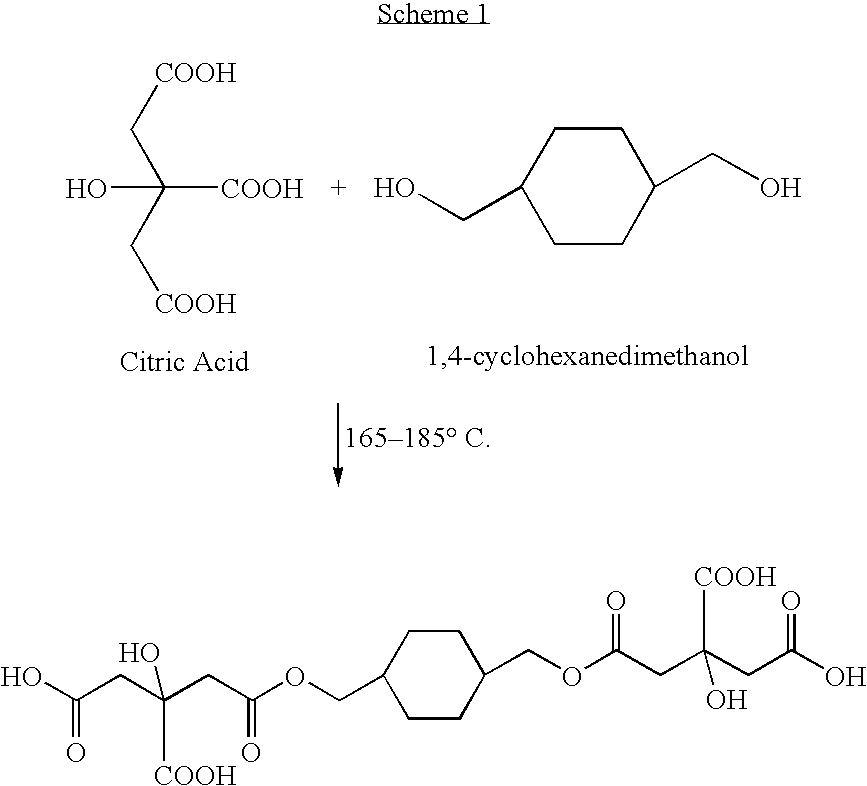Treatment composition for making acquisition fluff pulp in sheet form
- Summary
- Abstract
- Description
- Claims
- Application Information
AI Technical Summary
Benefits of technology
Problems solved by technology
Method used
Image
Examples
example 1
[0092] This example illustrates a representative method for making an acquisition fluff pulp of the present invention.
[0093] A treatment composition solution was prepared from citric acid (35.0 g) and 1,4-cyclohexanedimethanol (20.0 g) in water (800 mL). The pH was adjusted to about 2.9 to 3.2 with an aqueous solution of NaOH (8.3 g, 50 wt %). After stirring for a few minutes, sodium hypophosphite (8.25 g, 23% by weight of citric acid) was added and the solution was stirred until the sodium hypophosphite was completely dissolved. More water was then added to adjust the concentration of the treatment composition in solution to about 5.5% by weight (final weight of solution is 1.0 kg). The final concentration of polycarboxylic acid in solution was 3.5% by weight.
[0094] The produced treatment composition solution then was used to treat the following wood pulps: [0095] (1) “Rayfloc®-J-LD” is an untreated southern pine Kraft pulp commercially available from Rayonier, Inc., for use in a...
example 2
[0101] This example illustrates the effect of using treatment compositions prepared using citric acid with various modifying agents, on absorbent properties of representative acquisition fluff pulp formed in accordance with the present invention.
[0102] Three treatment composition solutions were prepared in accordance with the method described in Example 1. Each solution contained a citric acid cross-linking agent (3.5% by weight) and a modifying agent (2.0% by weight). The first treatment composition contained a 1,4-cyclohexanoldimethanol modifying agent; the second treatment composition contained a tri(propylene glycol) methyl ether modifying agent, and the third treatment composition contained a tri(propylene glycol) modifying agent. Each treatment composition solution was used to treat a sample of Rayfloc®-J-LD fibers, using the method described in Example 1. The treated fiber samples were cured and dried at 185° C. for about 12 minutes to produce acquisition fluff pulp samples....
example 3
[0103] This example illustrates the effect of using treatment compositions prepared using various polycarboxylic acids in addition to the CHDM modifying agent, on fiber quality and absorbent properties of acquisition fluff pulp formed in accordance with the present invention.
[0104] Three treatment composition solutions were prepared in accordance with the method described in Example 1, each solution containing a different mixture of polycarboxylic acids as shown in Table 4 below. All solutions contain 1% by weight of modifying agent CHDM, and catalyst NaH2PO2 (about 33.3% by weight of polycarboxylic acid). Each treatment composition solution was used to treat a sample of Rayfloc®-J-LD fibers, using the method described in Example 1. The treated fiber samples were cured and dried at 195° C. for about 10 minutes to produce acquisition fluff pulp samples. The samples were subsequently defiberized, using the method described in Example 1. Absorbent properties, fiber quality and ISO Bri...
PUM
| Property | Measurement | Unit |
|---|---|---|
| Temperature | aaaaa | aaaaa |
| Temperature | aaaaa | aaaaa |
| Temperature | aaaaa | aaaaa |
Abstract
Description
Claims
Application Information
 Login to View More
Login to View More - R&D
- Intellectual Property
- Life Sciences
- Materials
- Tech Scout
- Unparalleled Data Quality
- Higher Quality Content
- 60% Fewer Hallucinations
Browse by: Latest US Patents, China's latest patents, Technical Efficacy Thesaurus, Application Domain, Technology Topic, Popular Technical Reports.
© 2025 PatSnap. All rights reserved.Legal|Privacy policy|Modern Slavery Act Transparency Statement|Sitemap|About US| Contact US: help@patsnap.com



